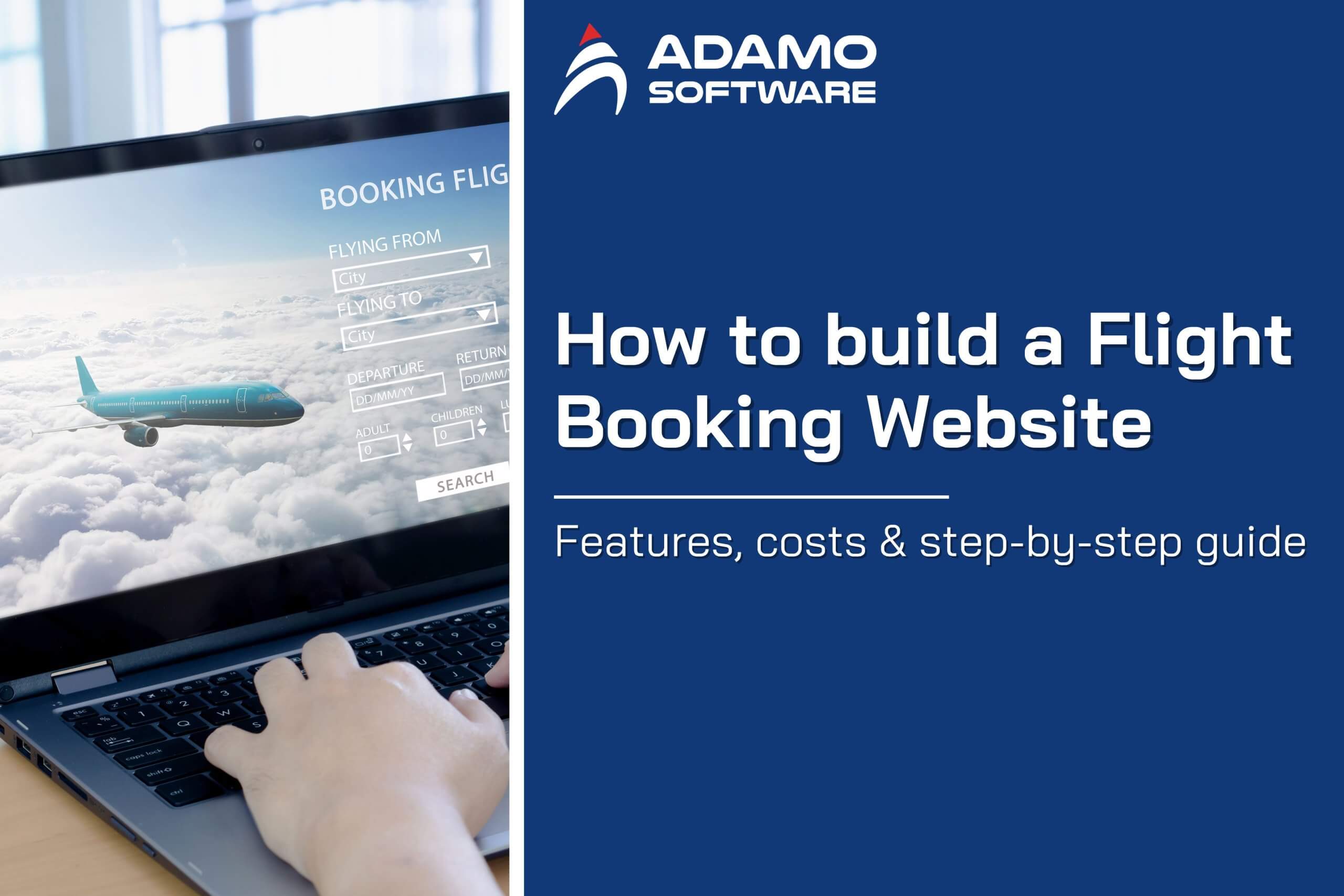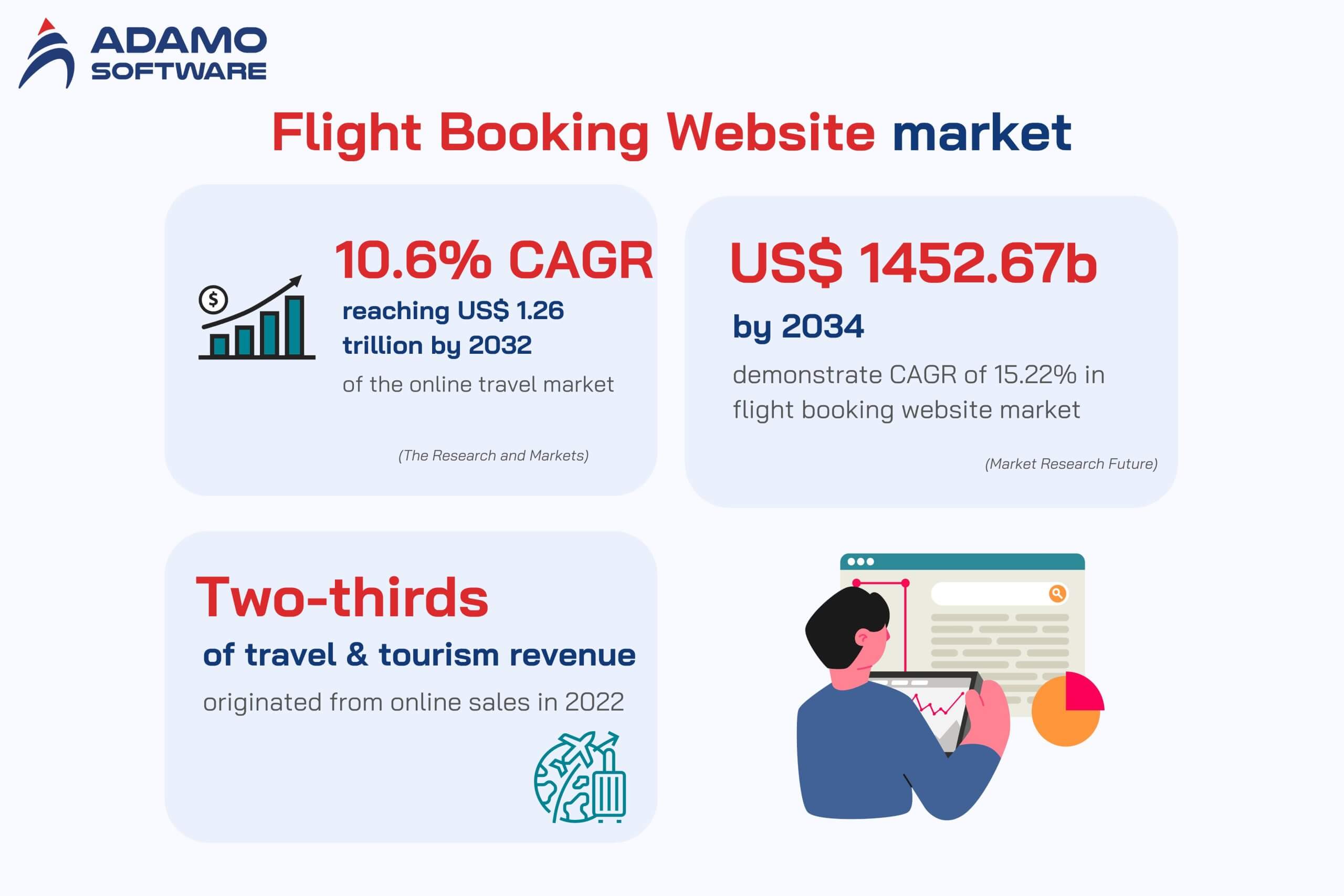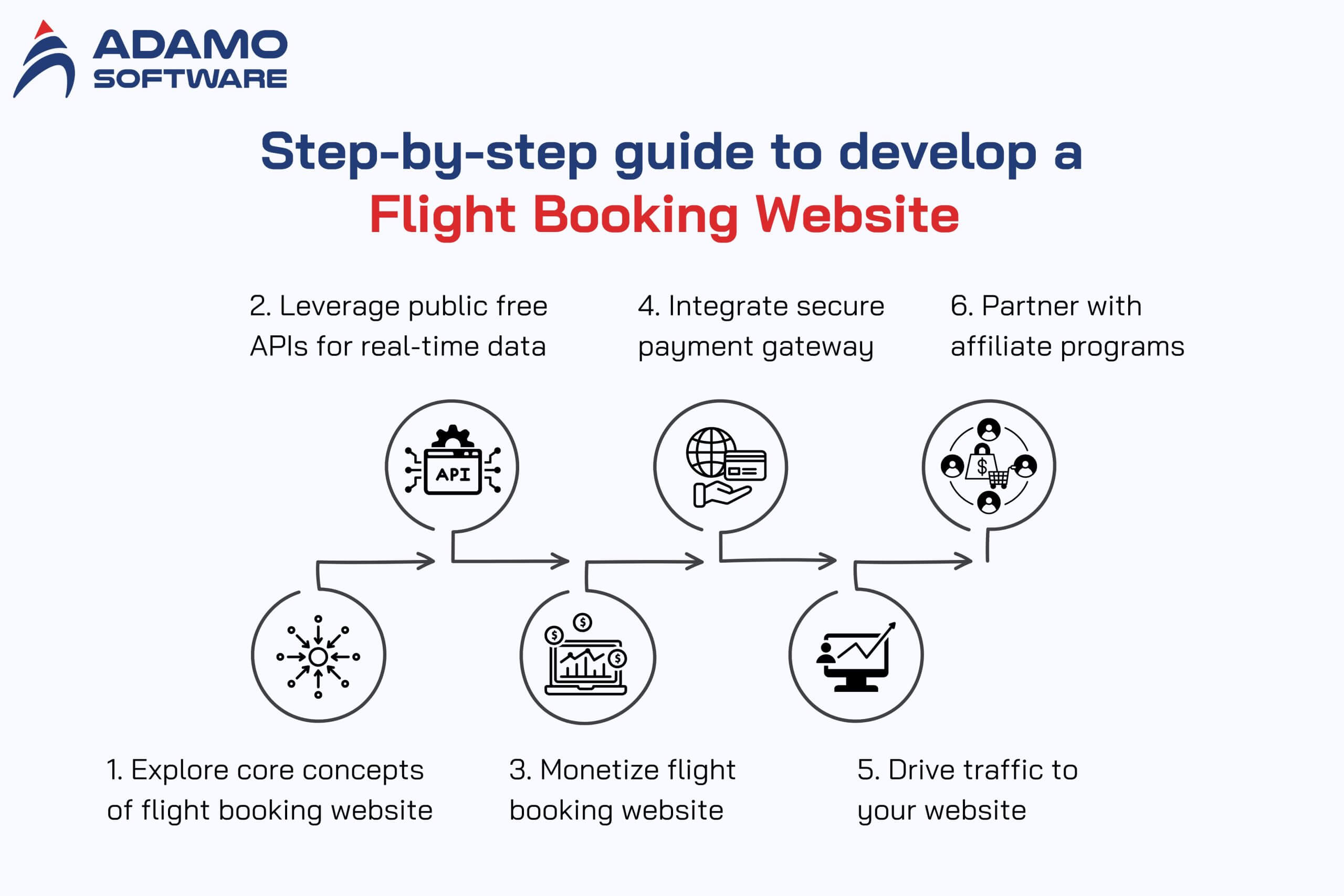How to Build a Flight Booking Website: Features, costs & step-by-step guide

Currently, a flight booking website is needed to serve travelers’ needs. Let Adamo Software discuss more about the website, its features, and development.
Currently, travelers need to travel by plane more. Thus, a flight booking webite is needed to serve travelers’ needs. The website enables users to find schedules, compare airline ticket prices, and make secure online payments easily, thereby enhancing their satisfaction. So, what is a flight booking website and its features? Let Adamo Software answer this question.
Through this blog post, you will have an overall view of the flight booking website market and the must-have features of the flight booking website. Besides, Adamo Software will break down the costs for website development. Additionally, you will get a step-by-step guide to developing the website. All information has been thoroughly researched and updated to the latest trends. So, let’s read our blog post and find some useful information!
I. How is current Flight Booking Website market?

According to Serhii Kholin, the CEO of Onix, and Mila Slesar, two-thirds of the travel and tourism revenue originated from online sales in 2022. The Research and Markets’ 2024 report shows that the online travel market, valued at US$512.5 billion in 2023, is projected to expand at an annual compound growth rate of 10.6%, reaching US$1.26 trillion by 2032. These statistics implicate the importance of developing a flight booking website, which is an indispensable part of the online travel sector.
The online booking engine itself is also outstanding. Market Research Future reveals that the flight booking website market is expected to grow from US$405.89 billion in 2025 to US$1452.67 billion by 2034, demonstrating a compound annual growth rate (CAGR) of 15.22% over the forecast period. The online airline booking market drivers include increased adoption of digital platforms for travel bookings, high demand for low-cost airlines, and surging business travel.
In general, the statistics above have shown the importance of developing a flight booking website. With its growth speed, this market will continue to surge thanks to the high demand for low-cost airlines, the popularity of digital platforms, and the increase in business travel. Now, it’s time to look at some of the outstanding features of this website.
II. Key features of an effective flight booking website
For the travel industry market, a flight booking website is an essential tool to provide clients with a streamlined and efficient booking process. Let’s explore some must-have features of a flight booking website to make the most of it with Adamo Software!
1. Real-time availability
Real-time availability is among the most essential features of an effective flight booking website. Customers using the website typically see quick results that fit their choices and budgets. With this feature, travel companies can update the latest flight data. The flight availability, schedules, and fares that the website displays are always accurate. Thus, your customers can always book a flight with their preferences.
Your flight booking website can update real-time information when it is integrated with the global distribution system (GDS) or the airline’s API. Thanks to this, your users can update all information on one platform. Therefore, they can save time searching for information.
Users might face flight cancellation even when they have paid for that flight if your website does not update information instantly. This negatively impacts the user experience. Thus, you must have the real-time availability feature to enhance user satisfaction.
2. Multi-language support
Foreign users may use their native language to search for flight information and prices. Thus, a website with various languages is essential to serve these users.
When users can change the language of your website into their native language, they can use it more easily. This is one of the factors that encourages customers to keep using your website and services.
A native-language interface helps users better understand terms, policies, and flight details. This feature minimizes booking errors and allows customers to make accurate decisions.
Ready to Outsource?
Discover how we can transform your business with expert IT solutions.
3. Secure payment gateway
A secure payment gateway is one of the indispensable features of the flight booking website. It decides whether customers can trust and continue using your website in the future. It’s crucial to protect all transactions and user data, including credit card numbers and names. This prevents leaks and misuse of information.
Secure payment gateways encrypt credit cards and personal data, protecting against fraud. The more trust customers have, the more likely they are to return to using your service.
Your flight booking website must comply with international security standards such as PCI DSS (Payment Card Industry Data Security Standard). This fosters customer trust and defends the platform against cyberattacks, particularly during peak traffic.
Besides encryption, you can add two-factor authentication (2FA), OTP via phone, or AI-driven fraud prevention systems functions into your flight booking website. It helps safeguard user data and reduces refund or dispute-related risks.
4. User-friendly interface
Your flight booking website must be easy to use and navigate. An intuitive interface makes it simple for users of all tech skill levels. This enables your users to easily search for information, enter departure and arrival destinations. Besides, it will be simpler for them to choose flight dates and times, filter results, and make payments. The process should be intuitive, logical, and smooth.
In addition to content layout, the interface must adapt seamlessly to various devices such as desktops, laptops, tablets, and phones. Seamless mobile website performance is crucial for highly mobile users.
5. Seat selection
When users book a flight ticket from your flight booking website, they may also want to choose their seat in advance. A flight booking engine should allow customers to select their seats during the booking process.
The ability to choose seats near the window, aisle, front, or back, allows users a more comfortable and personalized flying experience. Thanks to this, customers can be more proactive in their flight journey.
6. Ancillary services
Adding ancillary services is also essential for your flight booking website. This feature makes your website a comprehensive platform for customers. Some additional services include purchasing extra baggage, selecting in-flight meals, booking airport transfers, purchasing travel insurance, or booking a hotel at your destination. By adding these functions into your website, you can allow your customers to personalize their trip in a single transaction.
Your customers will be more likely to stay loyal to your flight booking website if it can handle all of their requests. This streamlines the search process, ensuring a seamless and consistent experience.
7. Mobile responsiveness
As people are now likely to use smartphones to search for information thanks to its convenience, you may want your flight booking website to have a mobile-responsive design. A mobile-friendly website will help you enhance user experiences.
A mobile-optimized website provides a responsive layout, legible text and buttons, fast loading, and fewer booking steps. This smooth experience helps users complete purchases easily, leading to higher conversions and less cart abandonment.
8. Integration with other systems
Integration with other systems helps your flight booking website operate smoothly and expand service capacity. As mentioned above, by integrating with the global distribution system (GDS) or the airline’s API, you can let your users know the real-time flights, fares, seat availability and policies. This ensures that the information displayed on your website is always accurate and updated.
Besides GDS, you may also integrate your website with secure payment gateways and customer relationship management (CRM) tools. This integration ensures a smooth transaction process and helps you track user behavior, manage booking history, and conduct personalized marketing.
Overall, the above 8 features play an important role in building an effective ad competitive flight booking website. They help to improve user experience, optimize revenue, and scale quickly. Before learning essential steps to develop a flight booking website, let’s keep reading to see the cost of developing it first.
III. Costs breakdown for Flight Booking Website Development
Developing a professional flight booking website requires significant investment. The costs for the website development depend on your website’s technical feature complexity, tech stacks, licensed API and third-party service integration, number of staff in the development team and their wages, etc. According to OneClick, the costs for developing a flight booking website are the total costs of market research, design, development, testing, and marketing. Let’s see this table below for each phase’s responsibilities and costs.
| Phase | Responsibilities | Anticipated cost |
| Market research |
|
$1700 to $2100 |
| Design |
|
$2150 to $2300 |
| Development |
|
$6,350 to $7,250. |
| Testing |
|
$1,600 to $1,900 |
| Marketing |
|
$500 to $1,100 monthly |
Overall, the costs to build a flight booking website range from $12,500 to $15,000. The number can be changed based on the website’s complexity and scope.
IV. Step-by-step guide to develop a Flight Booking Website
Developing a flight booking website is complicated. It requires carefully combining user interface design, system integration, and high security. For efficient and cost-effective results, you may want to follow clear, planned steps from concept to operation. Let Adamo Software discuss some main steps to developing an online airline website.

1. Exploring the core concepts of a flight booking website
Before developing a flight booking website, you may want to understand the core concepts to create the website. This platform not only lets users find and book tickets, but it also includes a flight search, real-time airline data (GDS/API), seat selection, secure payment, and optional services like baggage, insurance, and hotel booking. By grasping this basic knowledge, you can clearly define technical requirements, plan in detail, and communicate effectively with your development team or technology partners.
2. Leverage public free APIs for real-time data
As mentioned above, APIs are crucial for a flight booking website, providing real-time flight data. There are now many free or freemium (limited free) APIs that allow access to data about flights, airports, airlines, and fares. These APIs allow your website to display available flights, delay/delay status, or compare prices from different airlines.
Below are some outstanding APIs that you may want to add to your website.
3. Skyscanner Flight Search API
Skyscanner Flight Search API is a tool that enables your flight booking website to retrieve flight data, fares, and compare prices from various airlines and travel agencies. The API supports flexible searches by origin/destination, date, and time, offering seamless real-time data integration for booking platforms.
- Aviationstack
Aviationstack is a free, easy-to-integrate API offering real-time flight data, including departures, arrivals, aircraft locations, and flight status. This is a great tool for your flight booking website to display live flight information from thousands of airlines and airports worldwide.
- Travelpayouts Flight API
Travelpayouts Flight API is a powerful tool for integrating flight data into your flight booking website. It provides information on fares, price trends, popular destinations, and real-time flight search. Data is updated from over 1,000 global travel partners, making it easy for users to compare and choose the right flight.
- OpenSky Network
OpenSky Network is also an API that you can integrate into your flight booking website. It is ideal for tracking real-time flight status and movement.
4. Monetizing your flight booking website
After your flight booking website goes live, it’s time for you to make it profitable. You can earn a commission on every ticket booked by partnering with airlines or travel agents. Travelpayouts and Skyscanner are two outstanding intermediary platforms. Besides, you can work with travel affiliates to earn from referrals.
Additionally, you can earn direct revenues from users by charging a service fee for each transaction, such as payment processing fees, seat selection fees, or customer support fees. Websites can earn additional revenue by selling additional luggage, meals, travel insurance, upgraded seating, or refund/exchange packages. Display advertising is also an ideal way to monetize your flight booking website. If you have stable traffic, you can sell advertising space on your website to airlines, hotels, and travel insurance.
5. Integrating a secure payment gateway
A secure and smooth payment process is crucial for customer satisfaction. Firstly, you may want to choose a suitable gateway for your flight booking website. Some popular gateways include Stripe, PayPal, Razorpay, and Tazapay. Next, let’s set up an account. It’s time for you to sign up with the selected gateway to obtain the necessary API keys for integration.
The payment interface needs to be designed to be simple, user-friendly, and support multiple types of cards, such as Visa, Mastercard, domestic, and e-wallets. They must be able to automatically display the method appropriate to the customer’s region. In addition, there should be a payment confirmation email and a booking status after the transaction is completed.
6. Driving traffic to your flight booking website
Your flight booking website must have some specific strategies to drive traffic. SEO optimization is one of the best ways to do this. Let’s use keywords like “Flight Booking Website,” “budget flight deals,” and “cheap airline tickets” in your content, titles, and meta descriptions.
Besides SEO optimization, you can also run Google Ads or Facebook Ads to quickly access to target audience. You can run Google Ads by keyword or display on travel-related pages. Facebook/Instagram Ads are also very effective for reaching young users and groups with frequent travel needs.
Additionally, by focusing on content marketing, you can attract users, keep them on your site longer, and increase your website’s credibility. Content should be useful, accurate, and updated regularly to build trust with users.
7. Partner with affiliate programs
Affiliate programs are a great way to boost your flight booking website’s revenue. It is suitable for startups or airline ticket booking websites that want to scale quickly without spending much on advertising. Let’s consider CJ Affiliate, Travelpayouts, and Expedia Affiliate Network. They are all reputable programs that provide diverse travel opportunities.
V. Why should you create an Online Flight Booking Website with Adamo Software
Are you looking for a partner to develop your own flight booking website? As one of Vietnam’s leading companies in technology, Adamo Software can be your ideal choice. Let’s see why you should create an online flight booking website with us!

1. Profound knowledge of the travel industry
Adamo Software has many years of experience developing technology solutions for businesses in the travel industry, including flight booking systems, hotels, package tours, and OTA platforms. Adamo’s software engineering team not only excels in technology but also deeply understands the behavior and needs of online travel users.
2. Flexible customization
Instead of using an available package solution, Adamo designs websites based on the specific requirements of each business. You can request API integration from airlines, multiple payment options, multilingual interfaces, and other extended features such as loyalty programs, push notifications, or a friendly CMS for your flight booking website.
3. High security and performance
Adamo builds highly secure systems for sensitive data, including payment and passenger information, by implementing strict security layers and complying with international standards like PCI DSS. Simultaneously, the system performance is always optimized to ensure users have a smooth experience even during peak hours.
4. Providing long-term support and maintenance
Beyond the initial deployment, Adamo provides ongoing maintenance, upgrades, and technical support. This helps you maintain stable operations and be ready to scale when needed.
Overall, if you are looking for a reliable technology partner to develop an online flight booking website, consider Adamo Software. With deep expertise in the travel and hospitality software development industry, flexible customization capabilities, and professional services, Adamo can help you build a modern digital platform to serve your business’s purposes.
Still hesitating whether to choose Adamo Software? Let’s contact us for more detailed information!
FAQs
1. Are there distinctions in the development process for a travel booking website versus a mobile app?
Yes, they are different in the technologies and tools used and the user experience. While websites prioritize cross-browser accessibility and flexible layouts, mobile apps require optimization for specific operating systems (iOS, Android) and deeper integration with device features such as push notifications or GPS.
2. How long does it take to build an online flight booking website for a travel business?
The time to build an online flight booking website for a travel business usually ranges from 3 to 6 months, depending on the complexity, number of features, and scale of the system. If using available solutions or integrating APIs from third parties, the time can be significantly shortened.
3. What are the key considerations before building a flight booking website?
You must consider the market conditions, competition, target audience, and key types and features of your flight booking website. Besides, legal and security compliance, strategies to generate revenue for your website, and estimated costs to build your flight booking website must also be focused on.











